Improved Control of Radiator Heating Systems with Thermostatic Radiator Valves without Pre-Setting Function
Abstract
:1. Introduction
2. Case Study
3. Methodology
3.1. Overview of the Research Procedure
3.2. Equations Describing the Operation of the Heating System Used for the Creation of the Thermal-Hydraulic Model
3.3. Expected Daily Average DH Return Temperature from the Actual Building Case
3.4. First Strategy: Low-Flow System Operation
3.5. Second Strategy: High-Flow System Operation
3.6. Weather Compensation Curve Proposal
4. Results from Analysis
5. Test of the Two Strategies in the Actual Heating System
5.1. Temperature Measurements in the Substation, the Risers, and the Radiators of a Few Apartments
5.2. Return Temperature Measurements before Improvements
5.3. Test of the First Strategy: Low-Flow Operation
5.4. Test of the Second Strategy: High-Flow Operation
6. Proposal for the Implementation of the High-Flow Strategy
7. Discussion
8. Conclusions
Author Contributions
Funding
Conflicts of Interest
References
- European Commission. Energy Efficiency—Heating and Cooling. Available online: https://ec.europa.eu/energy/en/topics/energy-efficiency/heating-and-cooling (accessed on 29 May 2019).
- Tunzi, M.; Østergaard, D.S.; Svendsen, S.; Boukhanouf, R.; Cooper, E. Method to investigate and plan the application of low temperature district heating to existing hydraulic radiator systems in existing buildings. Energy 2016, 113, 413–421. [Google Scholar] [CrossRef]
- Lund, H.; Werner, S.; Wiltshire, R.; Svendsen, S.; Thorsen, J.E.; Hvelplund, F.; Mathiesen, B.V. 4th Generation District Heating (4GDH) Integrating smart thermal grids into future sustainable energy systems. Energy 2014, 68, 1–11. [Google Scholar] [CrossRef]
- Connolly, D.; Lund, H.; Mathiesen, B.V.; Werner, S.; Möller, B.; Persson, U.; Boermans, T.; Trier, D.; Østergaard, P.A.; Nielsen, S. Heat Roadmap Europe: Combining district heating with heat savings to decarbonize the EU energy system. Energy Policy 2014, 65, 475–489. [Google Scholar] [CrossRef]
- European Commission. Europe 2020 Flagship Initiative Innovation Union SEC (2010) 1161; Publications Office of the European Union: Luxembourg City, Luxembourg, 2011. [Google Scholar]
- Analysis of Options to Move Beyond 20% Greenhouse Gas Emission Reductions and Assessing the Risk of Carbon Leakage. Available online: https://eur-lex.europa.eu/legal-content/EN/TXT/?uri=celex%3A52010DC0265 (accessed on 20 August 2019).
- European Commission. A Clean Planet for All. A European Strategic Long-Term Vision for a Prosperous, Modern, Competitive and Climate Neutral Economy COM (2018) 773. Available online: https://eur-lex.europa.eu/legal-content/EN/TXT/?qid=1560755311425&uri=CELEX:52018DC0773 (accessed on 20 August 2019).
- Østergaard, D.S. Heating of Existing Buildings by Low-Temperature District Heating. Ph.D. Thesis, Technical University of Denmark, Department of Civil Engineering, Lyngby, Denmark, 2018. [Google Scholar]
- Gadd, H.; Werner, S. Achieving low return temperatures from district heating substations. Appl. Energy 2014, 136, 59–67. [Google Scholar] [CrossRef] [Green Version]
- Gadd, H.; Werner, S. Fault detection in district heating substations. Appl. Energy 2015, 157, 51–59. [Google Scholar] [CrossRef] [Green Version]
- Østergaard, D.S.; Svendsen, S. Theoretical overview of heating power and necessary heating supply temperatures in typical Danish single-family houses from the 1900s. Energy Build. 2016, 126, 375–383. [Google Scholar] [CrossRef] [Green Version]
- Østergaard, D.S.; Svendsen, S. Experience from a practical test of low-temperature district heating for space heating in five Danish single-family houses from the 1930s. Energy 2018, 159, 569–578. [Google Scholar] [CrossRef]
- Østergaard, D.S.; Svendsen, S. Are typical radiators over-dimensioned? An analysis of radiator dimensions in 1645 Danish houses. Energy Build. 2018, 178, 206–215. [Google Scholar] [CrossRef]
- Danish Standards. DSF/DS 418—Calculation of Heat Loss from Buildings; Danish Standards: København, Denmark, 2011. [Google Scholar]
- Lauenburg, P. Improved Supply of District Heat to Hydronic Space Heating Systems. Ph.D. Thesis, Lund University, Faculty of Engineering, Department of Energy Sciences, Division of Efficient Energy Systems, Lund, Sweden, 2009. [Google Scholar]
- Danish Standards. DS/EN 14336—Heating Systems in Buildings—Installation and Commissioning of Water Based Heating Systems; Danish Standards: København, Denmark, 2005. [Google Scholar]
- Trüschel, A. Hydronic heating systems the effect of design on system sensitivity. Doktorsavhandlingar vid Chalmers Tekniska Högskola 2002, 1857, 1–226. [Google Scholar]
- Monetti, V.; Fabrizio, E.; Filippi, M. Impact of low investment strategies for space heating control: Application of thermostatic radiators valves to an old residential Application of thermostatic radiators valves to an old residential. Energy Build. 2015, 95, 202–210. [Google Scholar] [CrossRef]
- Xu, B.; Huang, A.; Fu, L.; Di, H. Simulation and analysis on control effectiveness of TRVs in district heating systems. Energy Build. 2011, 43, 1169–1174. [Google Scholar] [CrossRef]
- Liao, Z.; Swainson, M.; Dexter, A.L. On the control of heating systems in the UK. Build. Environ. 2005, 40, 343–351. [Google Scholar] [CrossRef]
- Bruce-Konuah, A.; Jones, R.V.; Fuertes, A.; Messi, L.; Giretti, A. The role of thermostatic radiator valves for the control of space heating in UK social-rented households. Energy Build. 2018, 173, 206–220. [Google Scholar] [CrossRef]
- Zinko, H.; Lee, H.; Kim, B.K.; Kim, Y.H.; Lindkvist, H.; Loewen, A.; Ha, S.; Walletun, H.; Wigbels, M. Improvement of Operational Temperature Differences in District Heating Systems; Netherlands Agency for Energy and the Environment: Sittard, the Netherlands, 2005. [Google Scholar]
- Tahersima, F.; Stoustrup, J.; Rasmussen, H. Stability Performance Dilemma in Hydronic Radiators with TRV. In Proceedings of the 20th IEEE International Conference on Control Applications, Denver, CO, USA, 28–30 September 2011. [Google Scholar]
- Seiferta, J.; Knorr, M.; Meinzenbach, A.; Bitter, F.; Gregersen, N.; Krogh, T. Review of thermostatic control valves in the European standardization system of the EN 15316-2/EN 215. Energy Build. 2016, 125, 55–65. [Google Scholar] [CrossRef]
- Ashfaq, A.; Ianakiev, A. Investigation of hydraulic imbalance for converting existing boiler based buildings to low temperature district heating. Energy 2018, 160, 200–212. [Google Scholar] [CrossRef] [Green Version]
- Ljunggren, P.; Johansson, P.O.; Wollerstrand, J. Optimized space heating system operation with the aim of lowering the primary return temperature. In Proceedings of the 11th International Symposium on District Heating and Cooling, Reykjavik, Iceland, 31 August–2 September 2008. [Google Scholar]
- Lauenburg, P.; Wollerstrand, J. Adaptive control of radiator systems for a lowest possible district heating return temperature. Energy Build. 2014, 72, 132–140. [Google Scholar] [CrossRef]
- Gustafsson, J.; Delsing, J.; Deventer, J.V. Improved district heating substation efficiency with a new control strategy. Appl. Energy 2010, 87, 1996–2004. [Google Scholar] [CrossRef]
- Gustafsson, J.; Delsing, J.; Deventer, J.V. Experimental evaluation of radiator control based on primary supply temperature for district heating substations. Appl. Energy 2011, 88, 4945–4951. [Google Scholar] [CrossRef]
- Kiijärvi, J. Darcy Friction Factor Formulae in Turbulent Pipe Flow. Lunowa Fluid Mechanics Paper 110727. 2011. Available online: http://www.kolumbus.fi/jukka.kiijarvi/clunowa/fluid_mechanics/pdf_articles/darcy_friction_factor.pdf (accessed on 1 February 2019).


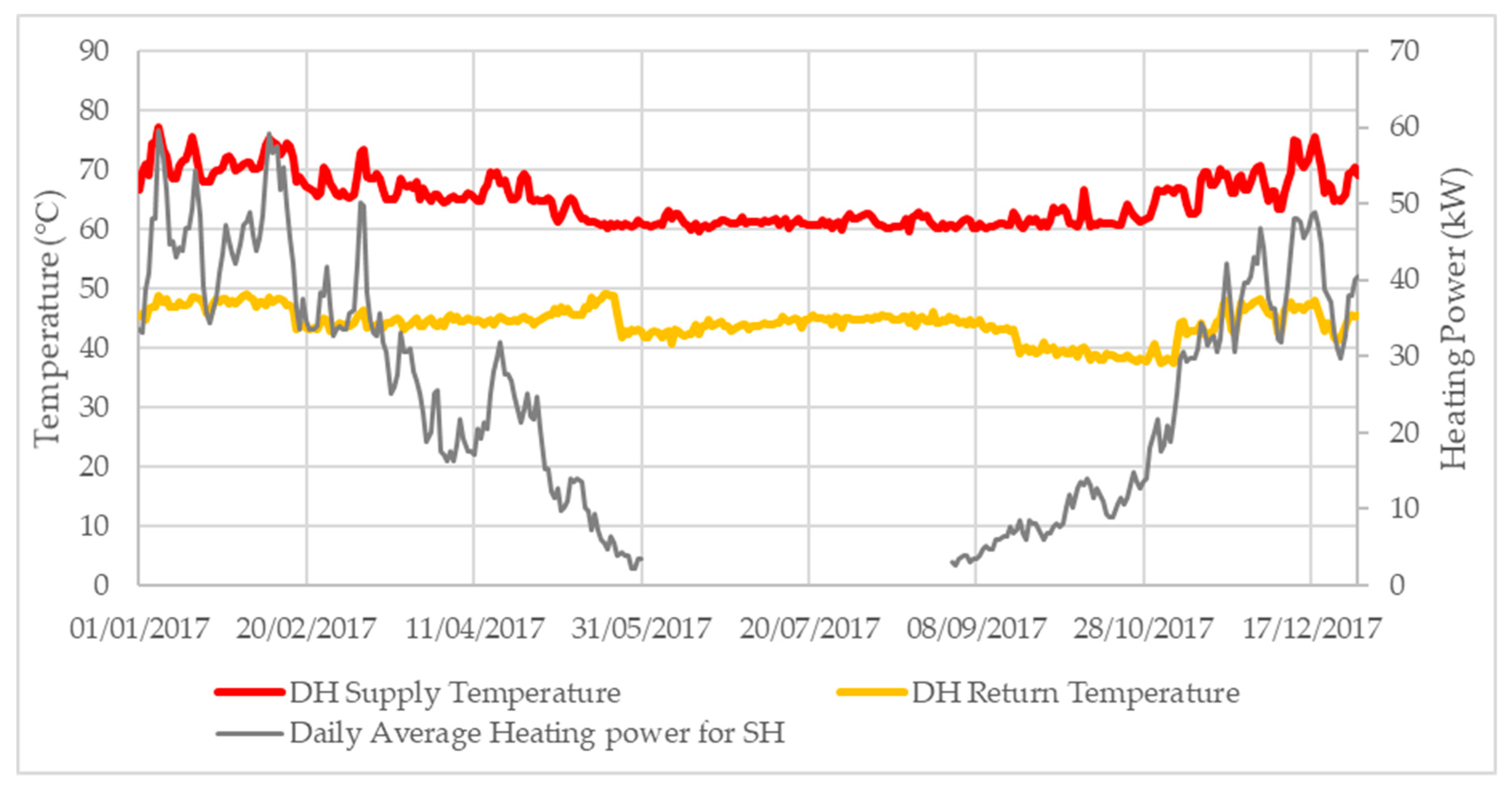
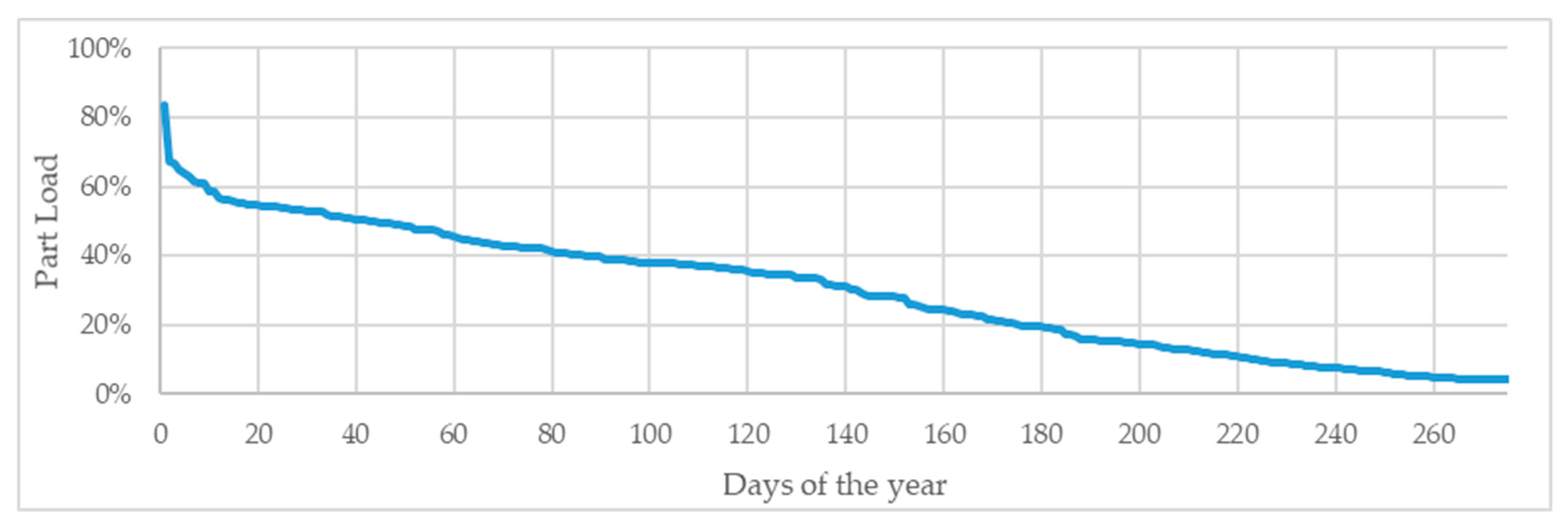

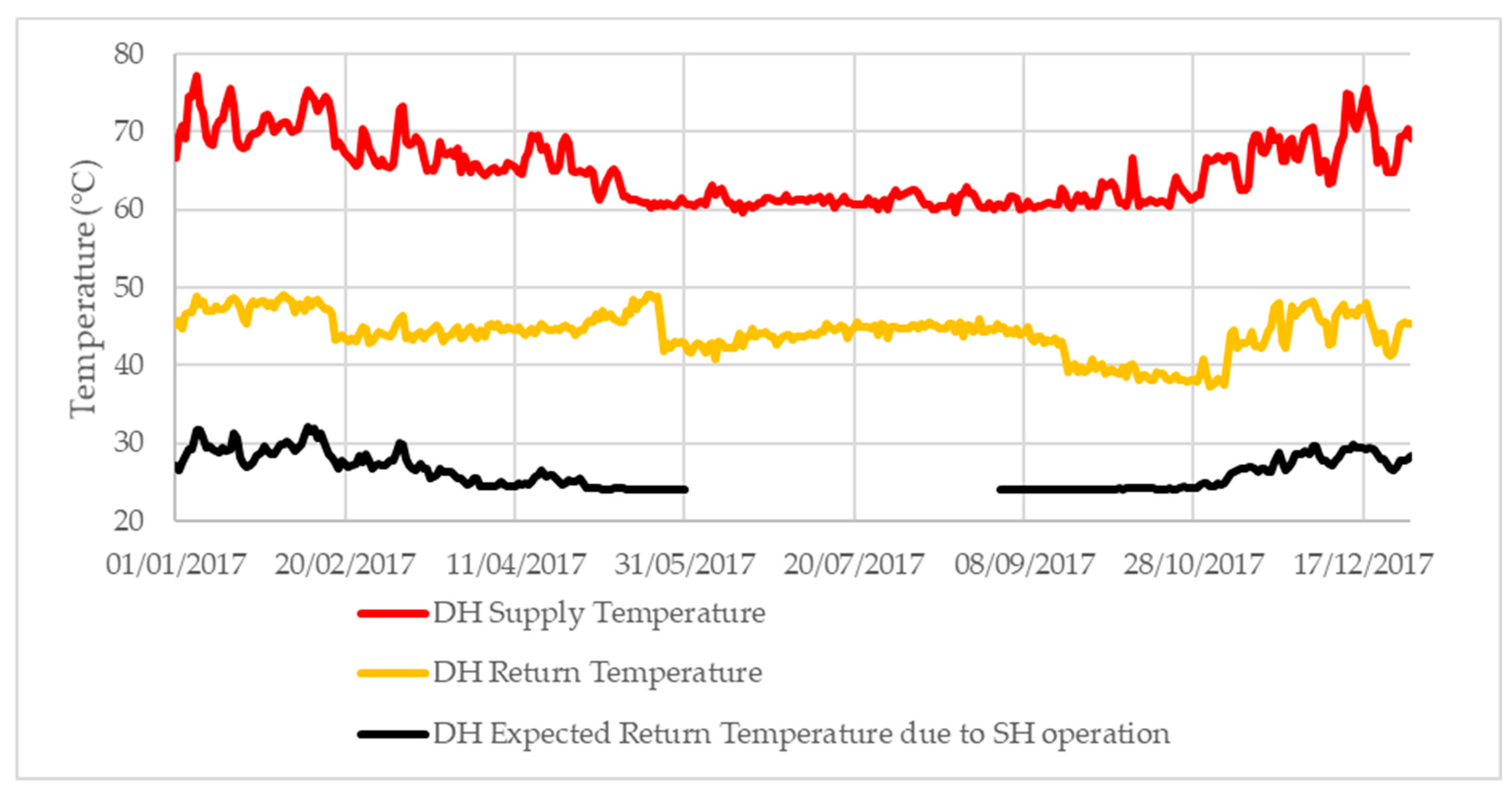

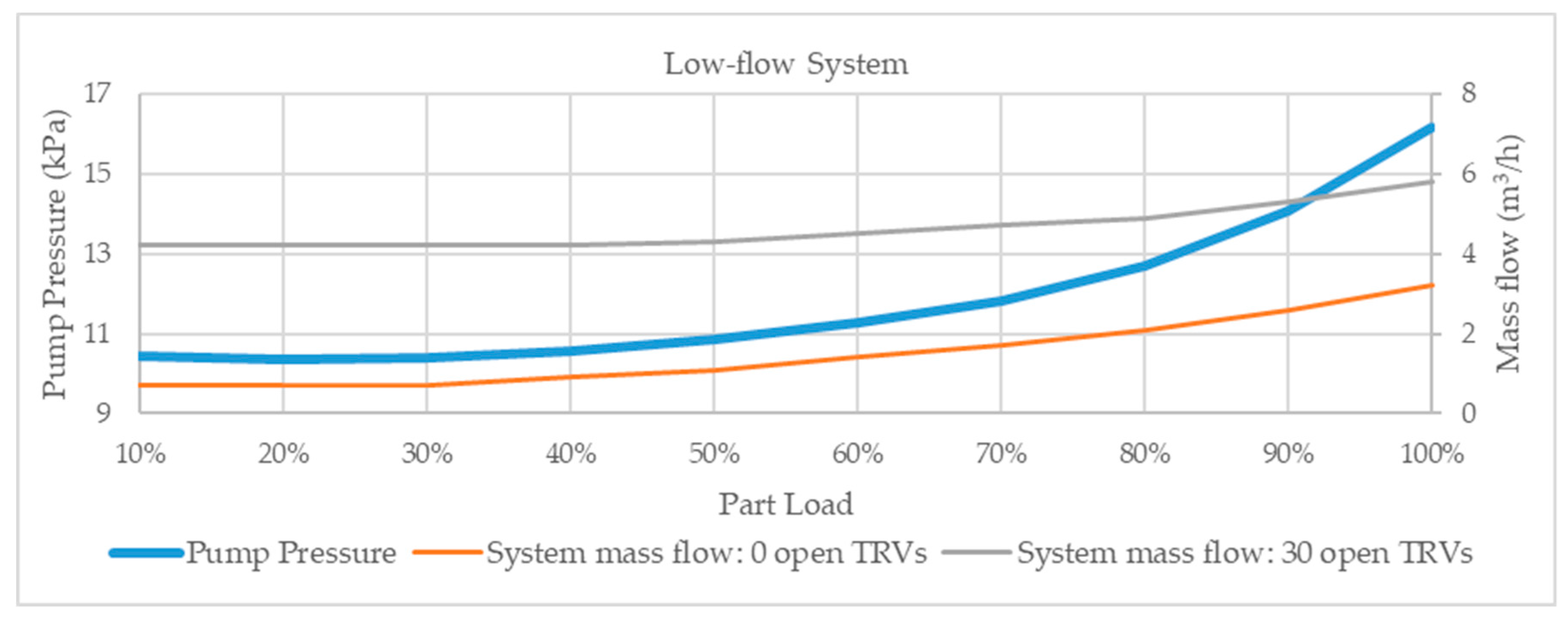


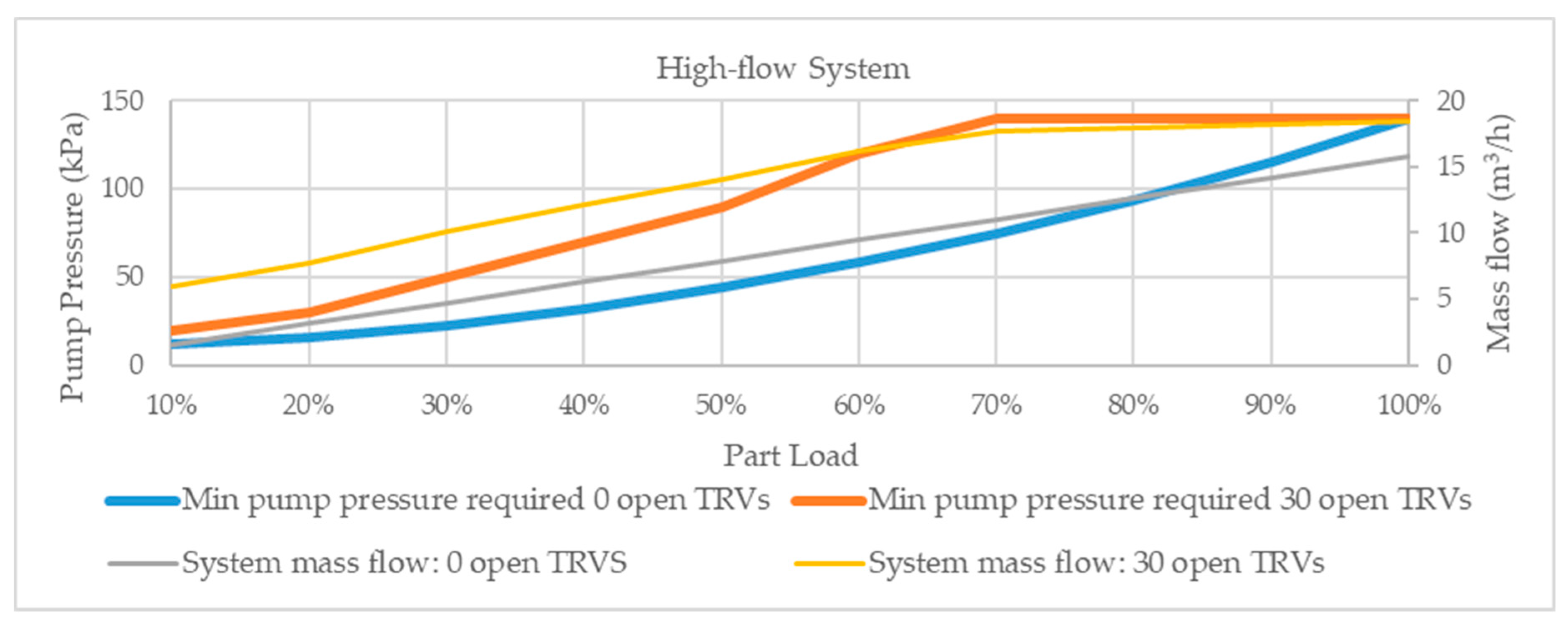
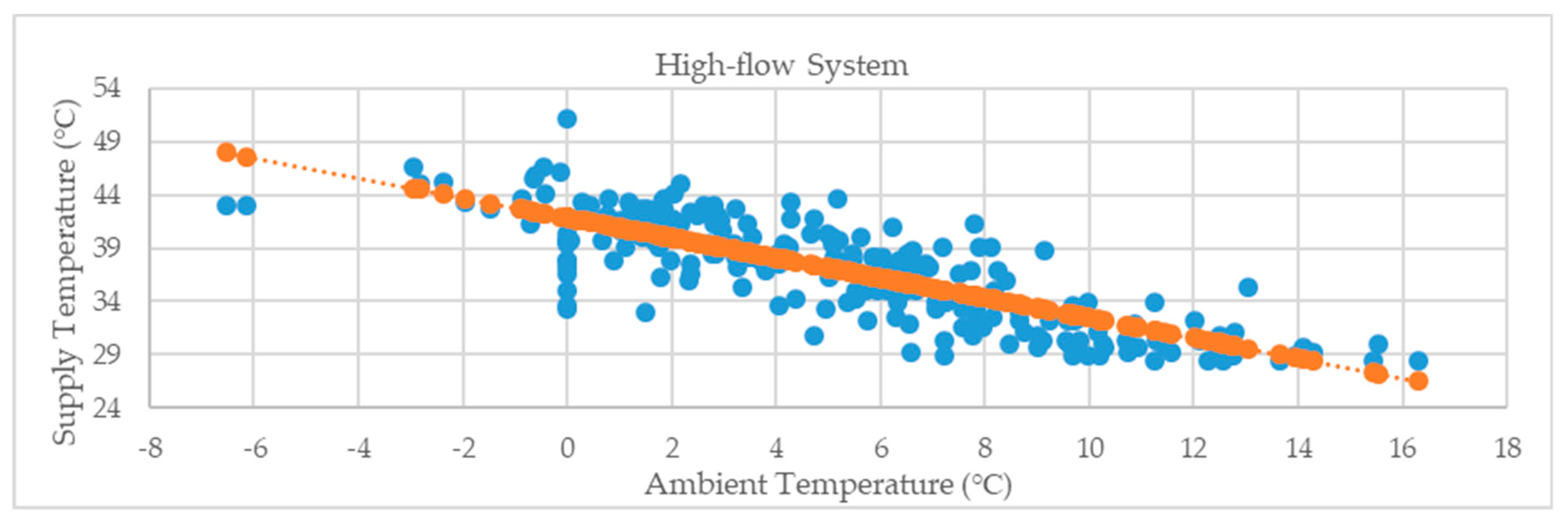
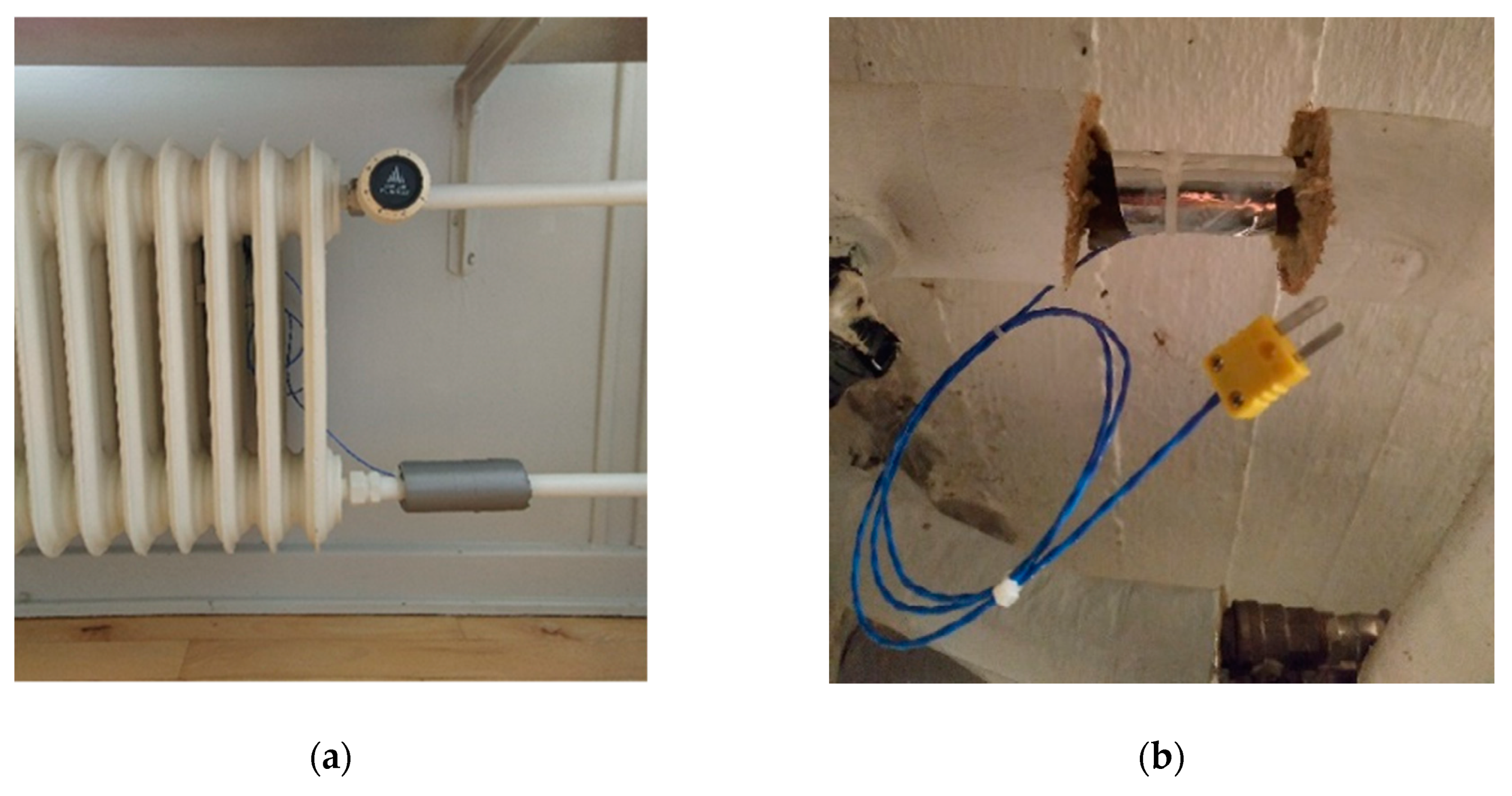


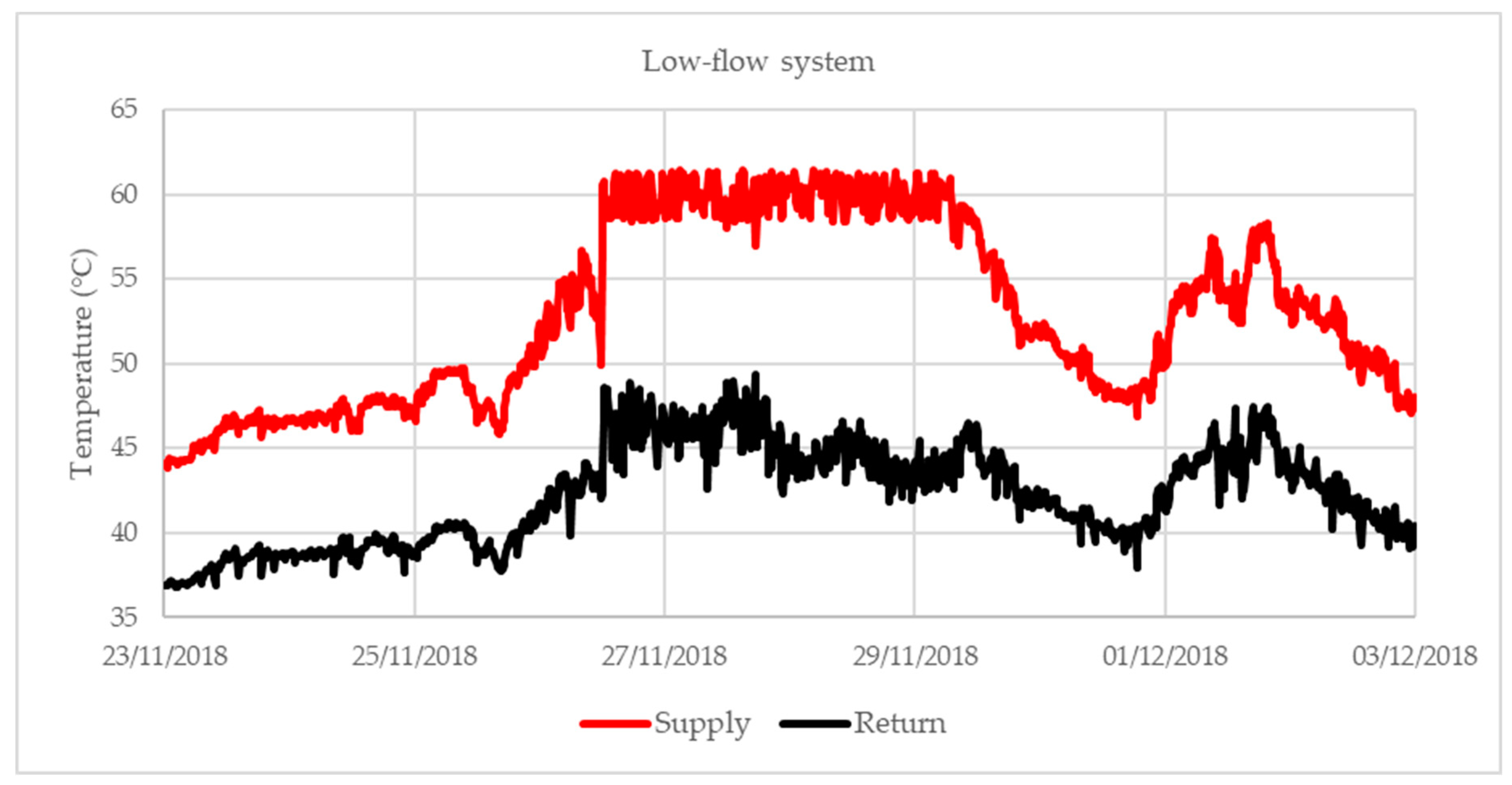
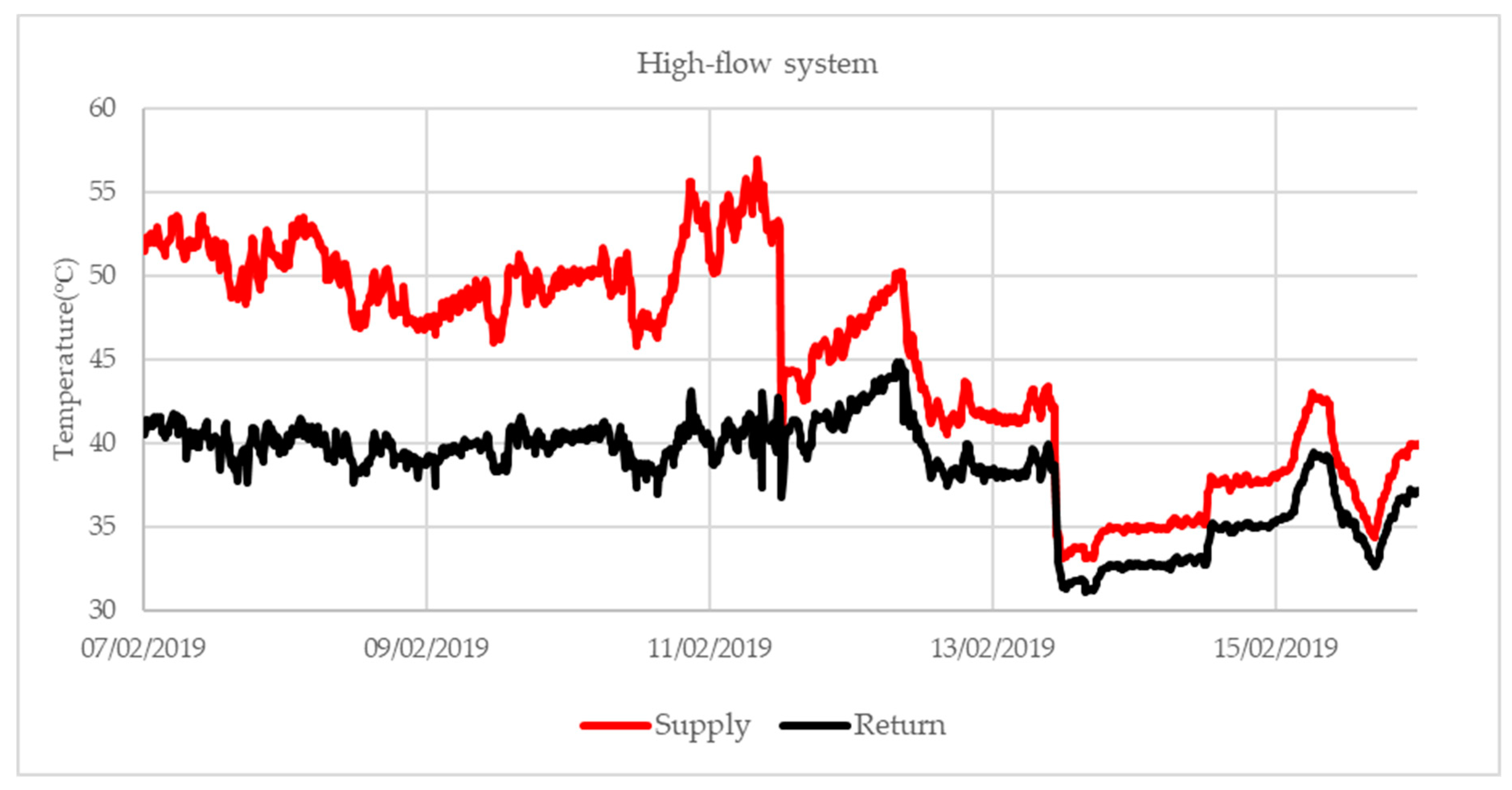
| Strategy | Modeled | Tested |
|---|---|---|
| Low-flow system operation (by fixing errors and improving the use of TRVs as requirements) | ✓ | ✓ |
| High-flow system operation | ✓ | ✓ |
| Step 1 | Selection of the supply temperature and the part load () conditions of the case. The design heat output () of each radiator in the system and the design supply and return temperatures are provided by the SH system operator and they are used as inputs for this calculation. |
| Step 2 | Calculation of the mass flow rate () and the pressure drop in every radiator, pipe section and the overall system for the reference case of the ideal operation of the system without errors, by using Equations (1)–(11). The minimum required pressure difference of the pump must be equal to the pressure drop of the system. |
| Step 1 | Selection of one radiator in every riser with a fully open TRV that leads into an uncontrolled flow. |
| Step 2 | Selection of the minimum required pressure difference of the pump (), calculated under the ideal operation of the radiator system, as an input for the mass flow recalculation in the case of a fully open TRV in every riser. |
| Step 3 | Iterative recalculation of the mass flow rate () and the pressure drop in every radiator, by using Equations (1)–(12), due to the existence of the uncontrolled flows in the system (), calculated from Equation (12), for the constant pump pressure difference () selected in Step 2. |
| Step 4 | Evaluation of the optimal operation of the TRVs in the system, by accepting a minimum pressure drop in every functional TRV () higher than 5 kPa. |
| Step 5 | In case there are several TRVs with a pressure drop lower than 5 kPa, a higher pressure difference of the pump (), is selected as an input and the calculation in Step 3 is repeated until the condition in Step 4 is fulfilled. |
| Step 6 | When the condition in Step 4 is fulfilled, and the mass flow rate in every radiator () is recalculated due to the existence of uncontrolled flows (, the return temperature from every radiator and the overall return temperature of the system are calculated by using Equation (13). |
© 2019 by the authors. Licensee MDPI, Basel, Switzerland. This article is an open access article distributed under the terms and conditions of the Creative Commons Attribution (CC BY) license (http://creativecommons.org/licenses/by/4.0/).
Share and Cite
Benakopoulos, T.; Salenbien, R.; Vanhoudt, D.; Svendsen, S. Improved Control of Radiator Heating Systems with Thermostatic Radiator Valves without Pre-Setting Function. Energies 2019, 12, 3215. https://doi.org/10.3390/en12173215
Benakopoulos T, Salenbien R, Vanhoudt D, Svendsen S. Improved Control of Radiator Heating Systems with Thermostatic Radiator Valves without Pre-Setting Function. Energies. 2019; 12(17):3215. https://doi.org/10.3390/en12173215
Chicago/Turabian StyleBenakopoulos, Theofanis, Robbe Salenbien, Dirk Vanhoudt, and Svend Svendsen. 2019. "Improved Control of Radiator Heating Systems with Thermostatic Radiator Valves without Pre-Setting Function" Energies 12, no. 17: 3215. https://doi.org/10.3390/en12173215






